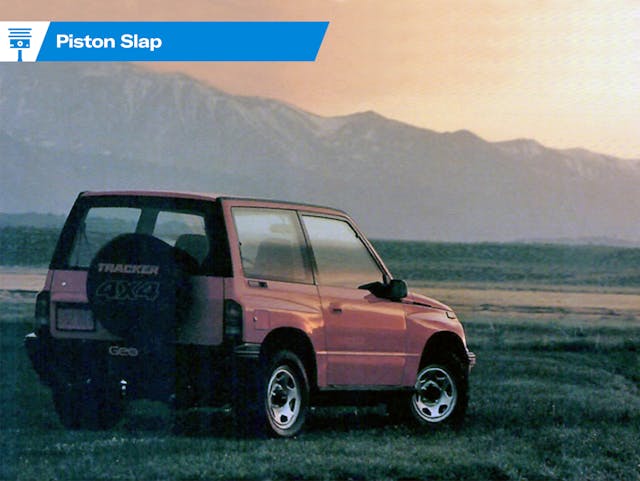Piston Slap: Groovy CV shafts for a troubled Geo Tracker?

Russ writes:
Hello, I recently purchased a 1990 Geo Tracker 4×4 and I’m doing some off-road modifications to it. While disassembling the front diff, I noticed the passenger side CV input shaft (the end that fits into the front diff) has a “waist” ground into it. I have a spare axle and that one does not. Can you explain why some of these axles have a waist? Here’s a link to an auction of axles with the “waist” design. (My glorious photoshop work showing the detail in particular is below. – SM)

My concern is this waist provides a weak point in the axle. More concerning is this could be a weak point INSIDE the diff, making quite a worry for field repair!
Sajeev answers:
That indeed looks like a flawed CV shaft design, so your concerns are also my concerns. Odds are that upgraded wheels/tires and truly off-road conditions will not be kind to this part, but Suzuki’s engineers probably didn’t care. Suzuki was likely catering to users interested in light off-roading on factory wheels/tires, cratered roads in third world nations, and whatever they called American mall crawling back in the 1990s.
A second potential justification for this design is to have an affordable, easily replaceable weak point to ensure lower warranty costs. Think about how much a manufacturer pays in warranty costs (HINT: it’s a lot), and think about the cost of a replacement CV shaft versus a new transfer case or differential. Metal shavings inside the differential is a concern (just change the gear oil?), but no matter—there’s clearly one weak link that’s “better” in terms of warranty costs.
But none of this answers your question. From my internet sleuthing, it appears the aftermarket made the upgrade you see in your parts stash. They clearly have more material left on their CV shaft at this end. While my luck with this brand has been spotty, it appears that Cardone #661085 is an improvement over the stock design.

The angled slots on the shaft likely promote lubricant coverage while the shafts are spinning away, but let’s zoom in and see the real difference.

That looks a lot beefier; no material was removed from the shaft. This design matches the one in your spare parts collection, I presume? And all aftermarket CV shafts for this application were probably made from the same design, in the same factory located in you know where … but I digress.
Just to ensure I am looking at the right end of this CV shaft, I watched this YouTube tutorial for confirmation. The video doesn’t necessarily confirm it, but it gives more evidence to my guesstimation that aftermarket CV shafts are better for your needs—provided the rest of the CV shaft is also designed to OEM specifications.
No matter, hopefully we got to the truth of why some shafts for the Geo Tracker/Suzuki Sidekick are beefier than others. If not, hopefully it was still a respectable educated guess. No matter what, I wish you many miles (or many hundreds of yards, depending on where you live) of engaging and entertaining off-roading in your modified Geo Tracker!
Have a question you’d like answered on Piston Slap? Send your queries to pistonslap@hagerty.com, give us as much detail as possible so we can help! If you need an expedited resolution, make a post on the Hagerty Community!

